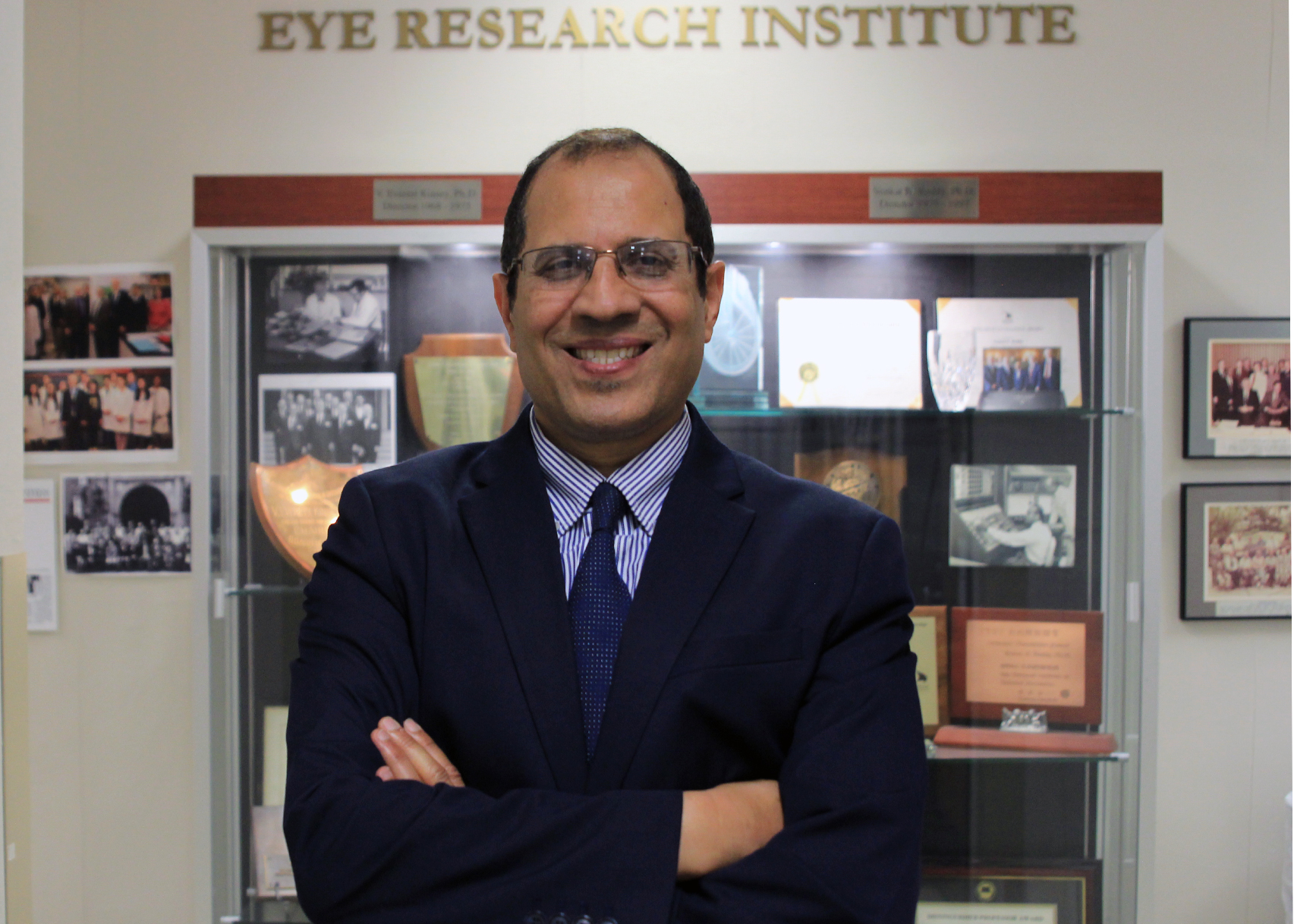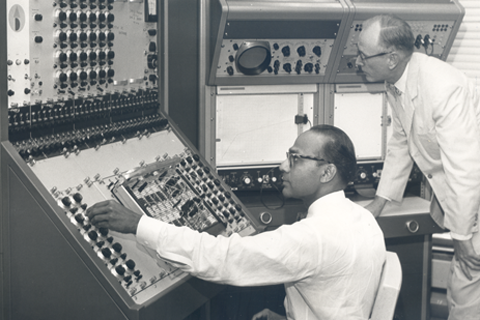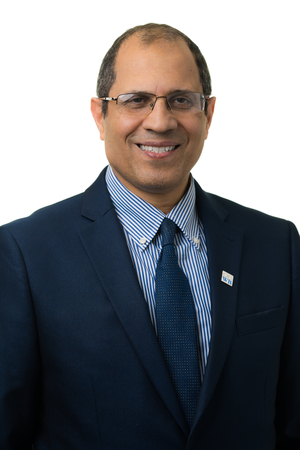
Eyes help us see, and some even say serve as windows to the soul, but they mean even more to Mohamed Al-Shabrawey, M.D., Ph.D.
The reason?
Al-Shabrawey — founding director of Oakland University William Beaumont School of Medicine’s Eye Research Center (ERC) — has built a life and career that revolves around eyes. Now, he has his sights on ramping up OUWB’s eye research and furthering Oakland University’s decades of success in the field.
He’s in prime position to make his vision a reality, too.
Not only was he recently named founding director of the ERC at OUWB, but also director of the OU Eye Research Institute (ERI), and the first V. Everett Kinsey Endowed Professor of Biomedical Sciences in the ERI. He’s also a professor in OUWB’s Department of Foundational Medical Studies.
“Our predecessors have created an excellent national reputation,” says Al-Shabrewey.
“We have a great opportunity to continue building on that success and create a dynamic framework with the ERI integrated with (OUWB) and other units at OU.”
A history of success
For their work over the last several decades toward preventing blindness and vision loss, ERI faculty members have received a total of more than $50 million in grants from public and private health agencies.
 |
| Venkat Reddy (seated) and V. Everett Kinsey, co-founders of the Oakland University Eye Research Institute, are pictured. |
OU’s ERI was founded in 1968 by V. Everett Kinsey, M.D., and Venkat N. Reddy, M.D. It began as a 10,000-square-foot facility funded by a National Institutes of Health Construction Grant.
The ERI was recognized as a center of excellence in vision research in 1984 with receipt of a Core Vision grant from the National Eye Institute. This helped the ERI expand via creation of staffed core facilities in electron microscopy and tissue culture.
In 1989, clinical professorial appointments in the ERI were granted to senior members of the Department of Ophthalmology at Beaumont Health. This helped foster collaborative research while providing a joint ophthalmology residency and fellowship program.
Reddy retired in 1997. Janet Blanks, Ph.D., served as director from 1997 to 2002. Frank Giblin, Ph.D., distinguished professor emeritus of biomedical sciences, succeeded Blanks.
In 2011, the ERI dedicated a new Pediatric Retinal Research Laboratory (PRRL). Funding from the Vision Research ROPARD Foundation helps support operation of the PRRL and has allowed the purchase of state-of-the-art retinal imaging equipment for use with animal models.
In 2014, the wife of Kinsey, Irene Kinsey Stare, left the ERI $3.7 million to establish an
Endowed Professorship in her husband's honor.
In 2021, Giblin retired after 47 years at OU.
Concurrently, OUWB founded the ERC to further support the mission of the ERI and provide additional resources to promote translational research and expand vision research at Oakland University. Al-Shabrawey began in his roles on Aug. 1.
“The goal of the new ERC and ERI is to conduct state-of-the-art research in vision sciences and ophthalmology to enhance the understand of fundamental process in ocular tissue that lead to eye diseases,” according to a director’s message from Al-Shabrawey on the ERC website.
The ERC and ERI have investigators who conduct full-time research that includes, but is not limited to, diabetic retinopathy, retinopathy of prematurity, retinal degenerative diseases and age-related macular degeneration.
‘Eyes really can be a mirror’
 |
| Al-Shabrawey |
Al-Shabrawey’s move to Michigan is among the latest highlights in a career that essentially began before he earned his medical degree (MBBCH), M.Sc., and Ph.D. from Mansoura University, in Egypt. That’s because it was a medical school internship that sparked his interest in eyes.
“I found that the eye can reflect all kinds of systemic diseases,” says Al-Shabrawey. “They can reflect hypertension, diabetes, aging, autoimmune diseases…the eye really can be a mirror for our body.”
He also learned that eyes can reflect what is happening with an individual’s central nervous system.
Possessing this knowledge and an excitement to learn more, Al-Shabrawey says he continued doing so. Those efforts included attending a 1995 lecture delivered by a visiting professor from Medical College of Georgia. The professor — Ruth Caldwell, Ph.D. — would end up inviting Al-Shabrawey to do part of his Ph.D. program at the Georgia institution.
He would go on to join the Vascular Biology Center at the Medical College of Georgia as a postdoctoral fellow and develop research experience in endothelial cell dysfunction associated with ischemic retinopathy.
Now an expert in the study of diabetic retinopathy — a major cause of blindness — Al-Shabrawey has published nearly 70 articles on the disease. His research funding has included major grants from the National Eye Institute and the American Heart Association. He currently has an NIH R01 grant that extends to 2024.
Immediately prior to joining OU and OUWB, Al-Shabrawey was with the Culver Vision Discovery Institute of Augusta University in Augusta, Georgia, since its establishment in 2008.
"Dr. Al-Shabrawey's leadership will further elevate ERI as a preeminent international resource for eye research, and his vision aligns with the legacy established by Dr. Kinsey and developed by Professor Giblin," said OU President Dr. Ora Hirsch Pescovitz, M.D., in a press release. "Working closely with researchers from around the university, the institute's multidisciplinary approach creates a dynamic research enterprise that ensures Oakland University has a major impact on diagnosing, treating, and preventing eye diseases."
A positive future
Al-Shabrawey has several goals for the immediate future: strengthen the infrastructure supporting eye research at OU/OUWB; established a new academic program focused on vision science; and expand collaboration within OU, regionally, nationally, and internationally.
“Vision science is an excellent model for mobilizing researchers from diverse fields, because the eye is affected by many diseases, from diabetes to cardiovascular disease to aging,” he says. “Our understanding of these diseases can be vastly improved through collaborative research across many fields, including various clinical disciplines, bioengineering, physics, neuroscience, bioinformatics, artificial intelligence and public health.”
| Related: |
Eye Research Institute receives $3.7M gift Endowed research professorship honors a life of service Eye Research Institute receives grant for instrument to study cataract disease |
Under Al-Shabrawey’s leadership, work already has begun on revamping the infrastructure. He’s also already been leading discussions about potential new academic programs.
Another big goal? Promote extramural research funds.
“With OUWB’s investment in vision science, the hope is that will open the to expanded funding, help with recruiting more faculty members, and expand general interest in the field,” he says.
Al-Shabrawey says he believes his attitude and approach to working with others will help him lead the ERC and ERI.
“I consider myself a team player who has the ability to look at the positive side of anything,” he says. “Nothing is perfect in the world, but if we focus on negativity, we’re not going to improve anything.”
In addition to his new roles at OU and OUWB, Al-Shabrawey says he’s looking forward to his first Michigan winter with his wife, Amany Tawfik, M.D., and their two youngest children (of five) who are 12-year-old twins.
“We had snow three times in all our years in Georgia,” Al-Shabrawey says with a laugh. “I’m expecting the kids will get all excited and take pictures because we’re not used to it.”
Among other things, he says, his family already is enjoying all of the Mediterranean food available in metro Detroit.
“It’s unbelievable here,” he says with a smile. “They don’t have it in the south.”
For more information, contact Andrew Dietderich, marketing writer, OUWB, at [email protected].
To request an interview, visit the OUWB Communications & Marketing webpage.
NOTICE: Except where otherwise noted, all articles are published under a Creative Commons Attribution 3.0 license. You are free to copy, distribute, adapt, transmit, or make commercial use of this work as long as you attribute Oakland University William Beaumont School of Medicine as the original creator and include a link to this article.

